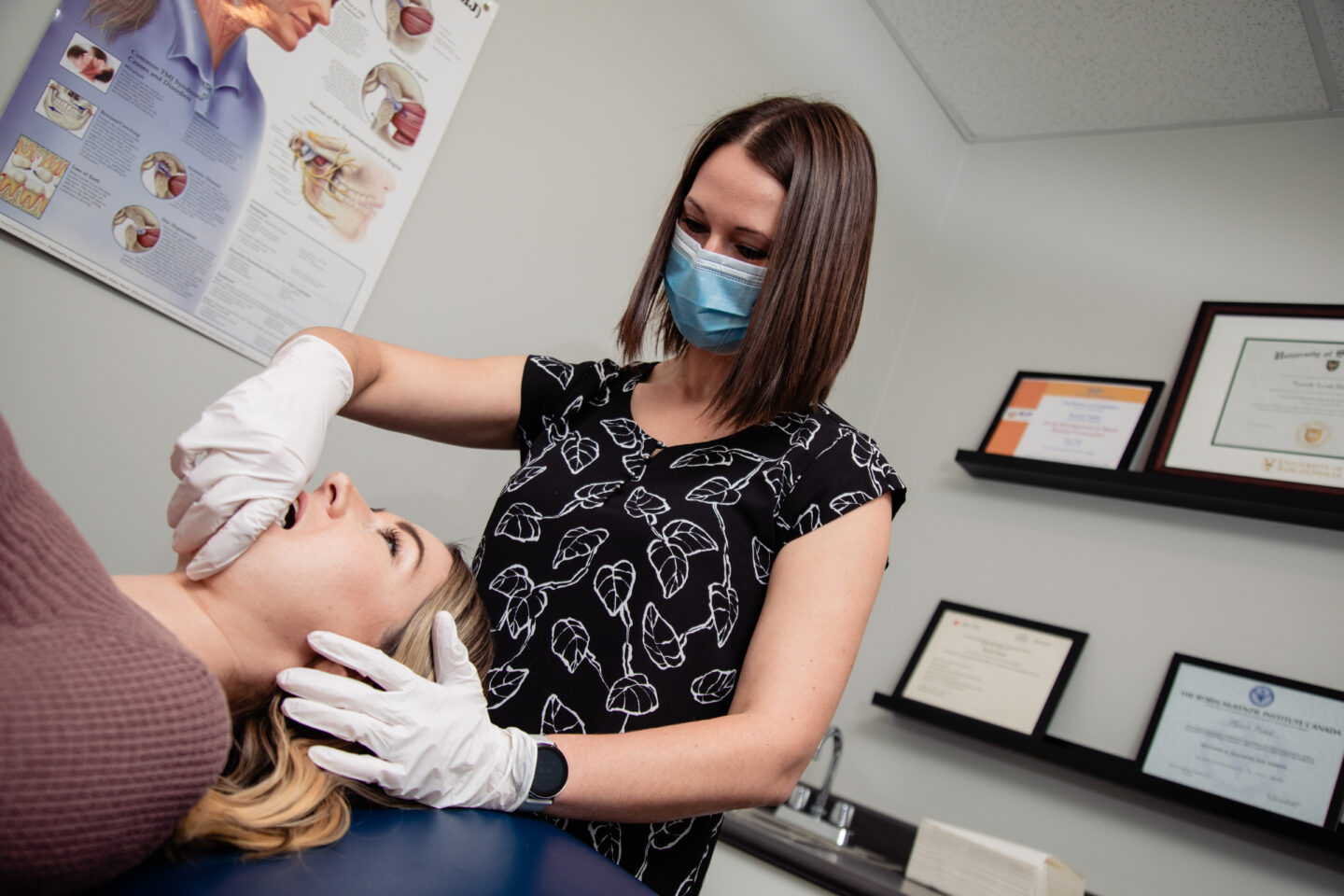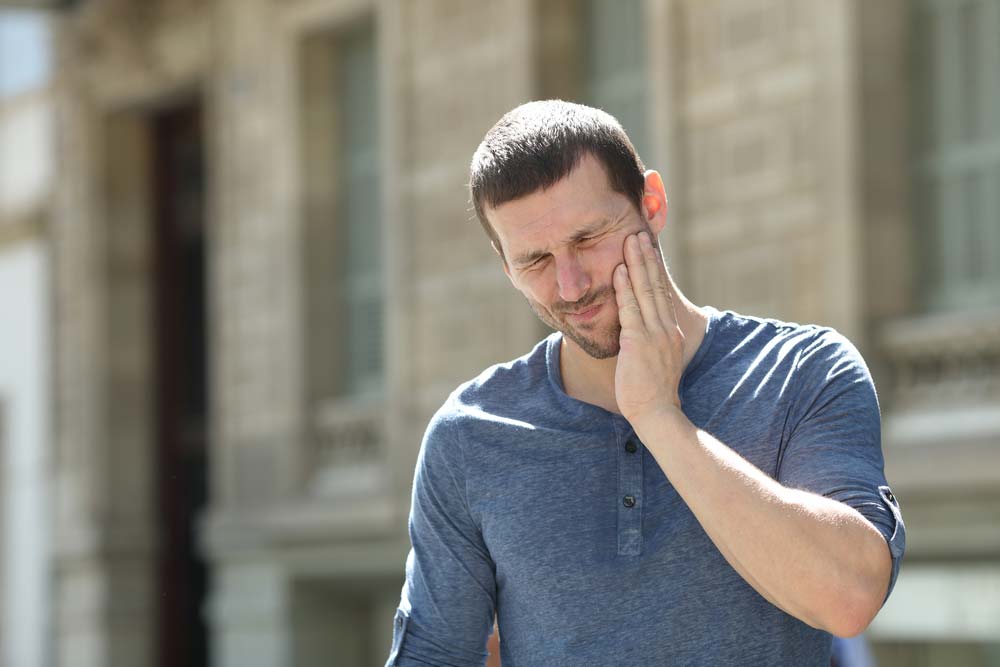There are many potential causes of jaw pain, and disorders of the temporomandibular joint (TMJ), as well as overuse of the muscles around the jaw are common reasons people feel pain in the jaw area. This is the area of your face connecting your jaw to your skull. The joints themselves are on either end of your jawbone and allow your mouth to open and close. Temporomandibular Disorder or TMD is a disorder of this area that can lead to pain. At North 49 Physical Therapy, we can provide treatment for pain caused by TMD.
Causes of Jaw Pain
Excessive Use
Problems with your TMJ are sometimes seen when these joints are irritated because of overuse or excessive clenching. You may feel pain in this area when you have been chewing gum or when you wake up in the morning after clenching your jaw in your sleep. Habits like chewing on your fingernails or biting the inside of your mouth may also contribute. You may also feel pain after chewing food that is especially tough or dense.
In addition to pain in your jaw, you may also hear popping or cracking sounds when you open and close your mouth. Another symptom is the temporary locking of your jaw. Pain from TMD may also be felt in the neck or ear, and you may mistake your symptoms for those of an ear infection or a respiratory problem. You may also experience dull, aching headaches due to issues with your TMJ because of the intense pressure in the whole area.
Traumatic Injury
Another potential cause of jaw pain or pain in the joints of your jaw is an injury to the area. This can happen because of force. For example, you may have run into something or been punched in the jaw. Sometimes jaw pain can even be the result of a car accident. If your pain is intense, your jaw bone may have been broken. This is likely to involve pain at the time of the accident as well as chronic pain in the future. Some symptoms of this include swelling and bruising of the area as well as acute pain or aching. You may also be missing teeth or have teeth come loose because of the impact.
Dental Issues
There are specific dental problems that can cause jaw pain in your TMJ. Advanced gum disease can actually cause your jaw bone to deteriorate, and that can lead to pain. You may also experience pain because of decayed or broken teeth. Wisdom teeth growing in can be a factor as well.
Arthritis
Rheumatoid arthritis can target the joints of your jaw. This is a disorder that causes the body to attack certain joints, making them swollen and irritated. Inflammation from these problems often causes pain and soreness. It may even affect your ability to properly open and close your mouth.
Heart Problems
Jaw pain is sometimes a symptom of a heart attack. The pain from a heart attack is sometimes felt in particular clusters of nerves, and sometimes this is in the jaw.
Diseases
Certain diseases can lead to pain and soreness in the jaw. One of these illnesses is mumps, which is characterized by the swelling of particular glands inside your mouth. The pressure from the swelling makes your jaw hurt. Another illness that can lead to jaw pain is tetanus. This disorder makes your muscles stiff and sore, and it is known for attacking the jaw bone as an early symptom.
Sinus Infection
Pressure and swelling from a sinus infection can cause pain in the jaw. This is especially true with sinus infections that take a long time to clear or return continuously and are considered chronic.
Exercises for Jaw Pain From TMD
Relax Your Muscles
This simple exercise involves intentionally relaxing your facial muscles completely. This can be harder than it sounds. Clear your mind of as many thoughts as possible and let your muscles relax and fall. Repeat this several times each day.
Chin Pull
Slowly pull your neck back so that you create the impression of a double chin. Hold this pose for 4 to 6 seconds and repeat several times. This may be easier to do if you stand with your back and head against a wall or other hard surface.
Chin Wiggle
Place your tongue lightly against the roof of your mouth directly behind your teeth. Allow the rest of your lower face to relax and fall open, keeping your tongue in place. Once in this position wiggle the jaw back and forth a few times. You can actually perform this frequently throughout the day to see how much you actually clench, because when you clench the jaw will not be able to wiggle back and forth. To see a demonstration of this exercise click here.
Trigger Point Massage
Press your fingers firmly into the place where you feel pain in the muscle with as much pressure as you can without increasing the pain. Rub slowly with pressure. Repeat this on any areas where you are feeling pain or soreness.
Temporomandibular Therapy
Treatment for this type of joint pain includes physical therapy that is approached in various ways. At North 49, one of our team members will help you control your jaw pain by talking to you specifically about exercises you can do to help alleviate your pain, and we will show you how to perform these movements for optimal results. You will also get a detailed plan about how often to use these exercises.

We will also talk to you about your lifestyle and suggest changes you can make that will lead to better management or even elimination of the pain you are experiencing. We will provide manual therapy, advise you how to perform self mobilization and massage, as well as discuss options such as heat and cold that may help. Finally, we will let you know if we believe you should see your dentist for a mouthguard or other apparatus that can help with behaviours contributing to the pain.
Contact Us Today
If you are experiencing joint pain, contact us at North 49 Physical Therapy for a consultation about how we can help you feel better. We are knowledgeable about TMD and have helped many people like you get relief from their pain. We will work with you to create a plan that includes different types of treatment and changes that will help you address your jaw pain.


